Performance of an Innovative Low-Cost Recycled Filling (LCRF) in Anaerobic Treatment of Dairy Effluent—A Pilot-Scale Study
Abstract
1. Introduction
2. Materials and Methods
2.1. Location
2.2. Experimental Design
2.3. Materials
2.3.1. Dairy Wastewater
2.3.2. Anaerobic Sludge
2.3.3. Lightweight Expanded Clay Aggregate Filling (LECAF)
2.3.4. Low-Cost Recycled Filling (LCRF)
2.4. Pilot-Scale Anaerobic Reactor Station
2.5. Analytical Methods
2.6. Statistical Analysis
3. Results and Discussion
3.1. Organic Matter Removal
3.2. Biogenic Pollutant Removal
3.3. Evolution of pH and Bacterial Community
3.4. Biogas and Methane Production
4. Conclusions
Author Contributions
Funding
Institutional Review Board Statement
Informed Consent Statement
Data Availability Statement
Conflicts of Interest
References
- Food and Agriculture Organization of the United Nations. Dairy Market Review, March 2020; FAO: Rome, Italy, 2020. [Google Scholar]
- Carolina Rafanhin Sousa, A.; Nascimento Makara, C.; Canniatti Brazaca, L.; Carrilho, E. A Colorimetric Microfluidic Paper-Based Analytical Device for Sulfonamides in Cow Milk Using Enzymatic Inhibition. Food Chem. 2021, 356, 129692. [Google Scholar] [CrossRef] [PubMed]
- OECD-FAO. OECD-FAO Agricultural Outlook 2020–2029; FAO: Rome, Italy, 2020. [Google Scholar]
- Pope, D.H.; Karlsson, J.O.; Baker, P.; McCoy, D. Examining the Environmental Impacts of the Dairy and Baby Food Industries: Are First-Food Systems a Crucial Missing Part of the Healthy and Sustainable Food Systems Agenda Now Underway? Int. J. Environ. Res. Public Health 2021, 18, 12678. [Google Scholar] [CrossRef] [PubMed]
- Karolinczak, B.; Abrowski, W.D.; Zyłka, R.; Dymaczewski, Z.; Zuorro, A. Evaluation of Dairy Wastewater Treatment Systems Using Carbon Footprint Analysis. Energies 2021, 14, 5366. [Google Scholar] [CrossRef]
- Żyłka, R.; Karolinczak, B.; Dąbrowski, W. Structure and Indicators of Electric Energy Consumption in Dairy Wastewater Treatment Plant. Sci. Total Environ. 2021, 782, 146599. [Google Scholar] [CrossRef]
- The European Dairy Association (EDA). Product Environmental Footprint Category Rules for Dairy Products; EDA: Brussel, Belgium, 2018. [Google Scholar]
- Stasinakis, A.S.; Charalambous, P.; Vyrides, I. Dairy Wastewater Management in EU: Produced Amounts, Existing Legislation, Applied Treatment Processes and Future Challenges. J. Environ. Manag. 2022, 303, 114152. [Google Scholar] [CrossRef]
- Vasina, A.I.; Basamykina, A.N. Local Wastewater Treatment Plant for Dairy Production: Challenges and Solutions. IOP Conf. Ser. Earth Environ. Sci. 2022, 988, 032077. [Google Scholar] [CrossRef]
- Bhuvaneshwari, S.; Majeed, F.; Jose, E.; Mohan, A. Different Treatment Methodologies and Reactors Employed for Dairy Effluent Treatment—A Review. J. Water Process Eng. 2022, 46, 102622. [Google Scholar] [CrossRef]
- Sathya, K.; Nagarajan, K.; Carlin Geor Malar, G.; Rajalakshmi, S.; Raja Lakshmi, P. A Comprehensive Review on Comparison among Effluent Treatment Methods and Modern Methods of Treatment of Industrial Wastewater Effluent from Different Sources. Appl. Water Sci. 2022, 12, 70. [Google Scholar] [CrossRef]
- Kaur, N. Different Treatment Techniques of Dairy Wastewater. Groundw. Sustain. Dev. 2021, 14, 100640. [Google Scholar] [CrossRef]
- Sinha, S.; Srivastava, A.; Mehrotra, T.; Singh, R. A Review on the Dairy Industry Waste Water Characteristics, Its Impact on Environment and Treatment Possibilities. Emerg. Issues Ecol. Environ. Sci. 2019, 73–84. [Google Scholar] [CrossRef]
- Ashraf, A.; Ramamurthy, R.; Rene, E.R. Wastewater Treatment and Resource Recovery Technologies in the Brewery Industry: Current Trends and Emerging Practices. Sustain. Energy Technol. Assess. 2021, 47, 101432. [Google Scholar] [CrossRef]
- Aziz, A.; Basheer, F.; Sengar, A.; Irfanullah; Khan, S.U.; Farooqi, I.H. Biological Wastewater Treatment (Anaerobic-Aerobic) Technologies for Safe Discharge of Treated Slaughterhouse and Meat Processing Wastewater. Sci. Total Environ. 2019, 686, 681–708. [Google Scholar] [CrossRef] [PubMed]
- Kong, Z.; Wu, J.; Rong, C.; Wang, T.; Li, L.; Luo, Z.; Ji, J.; Hanaoka, T.; Sakemi, S.; Ito, M.; et al. Large Pilot-Scale Submerged Anaerobic Membrane Bioreactor for the Treatment of Municipal Wastewater and Biogas Production at 25 °C. Bioresour. Technol. 2021, 319, 124123. [Google Scholar] [CrossRef] [PubMed]
- Zhang, M.; Leung, K.T.; Lin, H.; Liao, B. Effects of Solids Retention Time on the Biological Performance of a Novel Microalgal-Bacterial Membrane Photobioreactor for Industrial Wastewater Treatment. J. Environ. Chem. Eng. 2021, 9, 105500. [Google Scholar] [CrossRef]
- Preisner, M.; Neverova-Dziopak, E.; Kowalewski, Z. Analysis of Eutrophication Potential of Municipal Wastewater. Water Sci. Technol. 2020, 81, 1994–2003. [Google Scholar] [CrossRef] [PubMed]
- Dębowski, M.; Zieliński, M. Technological Effectiveness of Sugar-Industry Effluent Methane Fermentation in a Fluidized Active Filling Reactor (FAF-R). Energies 2020, 13, 6626. [Google Scholar] [CrossRef]
- Del’Duca, A.; Cesar, D.E.; Diniz, C.G.; Abreu, P.C. Evaluation of the Presence and Efficiency of Potential Probiotic Bacteria in the Gut of Tilapia (Oreochromis niloticus) Using the Fluorescent In Situ Hybridization Technique. Aquaculture 2013, 388–391, 115–121. [Google Scholar] [CrossRef]
- Ji, S.; Ma, W.; Wei, Q.; Zhang, W.; Jiang, F.; Chen, J. Integrated ABR and UASB System for Dairy Wastewater Treatment: Engineering Design and Practice. Sci. Total Environ. 2020, 749, 142267. [Google Scholar] [CrossRef]
- Mendez, R.; Blazquez, R.; Lorenzo, F.; Lema, J.M. Anaerobic Treatment of Cheese Whey: Start-up and Operation. Water Sci. Technol. 1989, 21, 1857–1860. [Google Scholar] [CrossRef]
- Arnaiz, C.; Buffiere, P.; Elmaleh, S.; Lebrato, J.; Moletta, R. Anaerobic Digestion of Dairy Wastewater by Inverse Fluidization: The Inverse Fluidized Bed and the Inverse Turbulent Bed Reactors. Environ. Technol. 2008, 24, 1431–1443. [Google Scholar] [CrossRef]
- Bella, K.; Rao, P.V. Anaerobic Digestion of Dairy Wastewater: Effect of Different Parameters and Co-Digestion Options—A Review. Biomass Convers. Biorefin. 2021, 2021, 1–26. [Google Scholar] [CrossRef]
- Purushothaman, K.; Jena, H.M. Biological Treatment of Synthetic Dairy Wastewater in FBBR. J. Indian Chem. Soc. 2020, 97, 2847–2853. [Google Scholar]
- Suksomboon, R.; Junsiri, C.; Tangjitjaroenkit, S.; El-Moselhy, M.M.; Padungthon, S. Mathematical Models of a Fluidized Bed Bioreactor Using Granular Activated Carbon (FBBR-GAC) for Wastewater Treatment. Eng. Appl. Sci. Res. 2019, 46, 183–191. [Google Scholar]
- Kundu, K.; Bergmann, I.; Hahnke, S.; Klocke, M.; Sharma, S.; Sreekrishnan, T.R. Carbon Source—A Strong Determinant of Microbial Community Structure and Performance of an Anaerobic Reactor. J. Biotechnol. 2013, 168, 616–624. [Google Scholar] [CrossRef] [PubMed]
- Debowski, M.; Zielinski, M.; Kisielewska, M.; Kazimierowicz, J. Evaluation of Anaerobic Digestion of Dairy Wastewater in an Innovative Multi-Section Horizontal Flow Reactor. Energies 2020, 13, 2392. [Google Scholar] [CrossRef]
- Dębowski, M.; Zieliński, M.; Kazimierowicz, J. Anaerobic Reactor Filling for Phosphorus Removal by Metal Dissolution Method. Materials 2022, 15, 2263. [Google Scholar] [CrossRef]
- Puñal, A.; Méndez-Pampín, R.J.; Lema, J.M. Characterization and Comparison of Biomasses from Single- and Multi-Fed Upflow Anaerobic Filters. Bioresour. Technol. 1999, 68, 293–300. [Google Scholar] [CrossRef]
- Ratusznei, S.M.; Rodrigues, J.A.D.; Zaiat, M. Operating Feasibility of Anaerobic Whey Treatment in a Stirred Sequencing Batch Reactor Containing Immobilized Biomass. Water Sci. Technol. 2003, 48, 179–186. [Google Scholar] [CrossRef]
- Najafpour, G.; Najafpour, G.D.; Hashemiyeh, B.A.; Asadi, M.; Ghasemi, M.B. Biological Treatment of Dairy Wastewater in an Upflow Anaerobic Sludge-Fixed Film Bioreactor. J. Agric. Environ. Sci. 2008, 4, 251–257. [Google Scholar]
- Dębowski, M.; Zieliński, M.; Kisielewska, M.; Krzemieniewski, M.; Makowska, M.; Grądkowski, M.; Tor-Świątek, A. Simulated Dairy Wastewater Treatment in a Pilot Plant Scale Magneto-Active Hybrid Anaerobic Biofilm Reactor (Ma-Habr). Braz. J. Chem. Eng. 2018, 35, 553–562. [Google Scholar] [CrossRef]
- Kisielewska, M.; Dȩbowski, M.; Zieliński, M.; Krzemieniewski, M. Enhancement of Dairy Wastewater Treatment in a Combined Anaerobic Baffled and Biofilm Reactor with Magneto-Active Packing Media. J. Ecol. Eng. 2018, 19, 165–171. [Google Scholar] [CrossRef]
- Zieliński, M.; Dębowski, M.; Kazimierowicz, J. Microwave Radiation Influence on Dairy Waste Anaerobic Digestion in a Multi-Section Hybrid Anaerobic Reactor (M-SHAR). Processes 2021, 9, 1772. [Google Scholar] [CrossRef]
- Ma, H.; Guo, Y.; Qin, Y.; Li, Y.Y. Nutrient Recovery Technologies Integrated with Energy Recovery by Waste Biomass Anaerobic Digestion. Bioresour. Technol. 2018, 269, 520–531. [Google Scholar] [CrossRef]
- Zhao, S.; Li, P.; Fang, H.; Song, L.; Li, D.; Liu, R.; Niu, Q. Enhancement Methane Fermentation of Enteromorpha Prolifera Waste by Saccharomyces Cerevisiae: Batch Kinetic Investigation, Dissolved Organic Matter Characterization, and Synergistic Mechanism. Environ. Sci. Pollut. Res. 2020, 27, 16254–16267. [Google Scholar] [CrossRef] [PubMed]
- Szwarc, K.; Szwarc, D.; Zieliński, M. Removal of Biogenic Compounds from the Post-Fermentation Effluent in a Culture of Chlorella Vulgaris. Environ. Sci. Pollut. Res. 2020, 27, 111–117. [Google Scholar] [CrossRef]
- Lee, H.S.; Tang, Y.; Rittmann, B.E.; Zhao, H.P. Anaerobic Oxidation of Methane Coupled to Denitrification: Fundamentals, Challenges, and Potential. Crit. Rev. Environ. Sci. Technol. 2018, 48, 1067–1093. [Google Scholar] [CrossRef]
- Tang, J.; Wang, X.C.; Hu, Y.; Pu, Y.; Huang, J.; Ngo, H.H.; Zeng, Y.; Li, Y. Nutrients Removal Performance and Sludge Properties Using Anaerobic Fermentation Slurry from Food Waste as an External Carbon Source for Wastewater Treatment. Bioresour. Technol. 2019, 271, 125–135. [Google Scholar] [CrossRef]
- Ai, S.; Liu, H.; Wu, M.; Zeng, G.; Yang, C. Roles of Acid-Producing Bacteria in Anaerobic Digestion of Waste Activated Sludge. Front. Environ. Sci. Eng. 2018, 12, 3. [Google Scholar] [CrossRef]
- Toyama, T.; Hanaoka, T.; Tanaka, Y.; Morikawa, M.; Mori, K. Comprehensive Evaluation of Nitrogen Removal Rate and Biomass, Ethanol, and Methane Production Yields by Combination of Four Major Duckweeds and Three Types of Wastewater Effluent. Bioresour. Technol. 2018, 250, 464–473. [Google Scholar] [CrossRef]
- Lin, R.; Cheng, J.; Yang, Z.; Ding, L.; Zhang, J.; Zhou, J.; Cen, K. Enhanced Energy Recovery from Cassava Ethanol Wastewater through Sequential Dark Hydrogen, Photo Hydrogen and Methane Fermentation Combined with Ammonium Removal. Bioresour. Technol. 2016, 214, 686–691. [Google Scholar] [CrossRef]
- Lu, Y.; Li, X.; Chen, Y.; Wang, Y.; Zhu, G.; Zeng, R.J. The Indispensable Role of Assimilation in Methane Driven Nitrate Removal. Sci. Total Environ. 2020, 746, 141089. [Google Scholar] [CrossRef] [PubMed]
- Liu, X.; Yang, H.; Chang, J.; Bai, Y.; Shi, L.; Su, B.; Han, J.; Liang, D. Re-Hydrolysis Characteristics of Alkaline Fermentation Liquid from Waste Activated Sludge: Feasibility as a Carbon Source for Nitrogen Removal. Process Saf. Environ. Prot. 2022, 165, 230–240. [Google Scholar] [CrossRef]
- Kisielewska, M.; Zielinski, M.; Debowski, M.; Kazimierowicz, J.; Romanowska-Duda, Z.; Dudek, M. Effectiveness of Scenedesmus sp. Biomass Grow and Nutrients Removal from Liquid Phase of Digestates. Energies 2020, 13, 1432. [Google Scholar] [CrossRef]
- Cristina, G.; Camelin, E.; Garofalo, S.F.; Salomone, F.; Pugliese, M.; Gullino, M.L.; Tommasi, T.; Fino, D. Time-Based Evaluation of Bioavailable Phosphorus in a Calcareous Soil after the Application of Anaerobically Digested Sewage Sludge. Biomass Convers. Biorefin. 2022, 1, 4361–4373. [Google Scholar] [CrossRef]
- Zhen, X.; Luo, M.; Li, Z.; Lin, Z.; Zhang, Y.; Feng, L.; Kang, J. The Sustainable Utilization of Anaerobic Digestion Effluents Treating in Suspended Filler Algae Assisted Systems. Sustain. Energy Technol. Assess. 2022, 53, 102354. [Google Scholar] [CrossRef]
- Li, L.; Pang, H.; He, J.; Zhang, J. Characterization of Phosphorus Species Distribution in Waste Activated Sludge after Anaerobic Digestion and Chemical Precipitation with Fe3+ and Mg2+. Chem. Eng. J. 2019, 373, 1279–1285. [Google Scholar] [CrossRef]
- Chuda, A.; Ziemiński, K. Challenges in Treatment of Digestate Liquid Fraction from Biogas Plant. Performance of Nitrogen Removal and Microbial Activity in Activated Sludge Process. Energies 2021, 14, 7321. [Google Scholar] [CrossRef]
- Akhiar, A.; Guilayn, F.; Torrijos, M.; Battimelli, A.; Shamsuddin, A.H.; Carrère, H. Correlations between the Composition of Liquid Fraction of Full-Scale Digestates and Process Conditions. Energies 2021, 14, 971. [Google Scholar] [CrossRef]
- Vaneeckhaute, C.; Lebuf, V.; Michels, E.; Belia, E.; Vanrolleghem, P.A.; Tack, F.M.G.; Meers, E. Nutrient Recovery from Digestate: Systematic Technology Review and Product Classification. Waste Biomass Valoriz. 2017, 8, 21–40. [Google Scholar] [CrossRef]
- von Sperling, M.; Almeida, P.G.S.; Bressani-Ribeiro, T.; Chernicharo, C.A.L. Post-Treatment of Anaerobic Effluents. In Anaerobic Reactors for Sewage Treatment: Design, Construction and Operation; IWA Publishing: London, UK, 2019; pp. 275–338. [Google Scholar] [CrossRef]
- Zielińska, M.; Zieliński, M.; Dębowski, M. Organic Compounds and Phosphorus Removal from Dairy Wastewater by Biofilm on Iron-Containing Supports. J. Environ. Eng. 2017, 144, 04017087. [Google Scholar] [CrossRef]
- Zieliński, M.; Dębowski, M.; Krzemieniewski, M.; Brudniak, A.; Kisielewska, M. Possibility of Improving Technological Effectiveness of Dairy Wastewater Treatment through Application of Active Fillings and Microwave Radiation. J. Water Chem. Technol. 2016, 38, 618–627. [Google Scholar] [CrossRef]
- You, G.; Wang, C.; Hou, J.; Wang, P.; Xu, Y.; Miao, L.; Liu, J. Effects of Zero Valent Iron on Nitrate Removal in Anaerobic Bioreactor with Various Carbon-to-Nitrate Ratios: Bio-Electrochemical Properties, Energy Regulation Strategies and Biological Response Mechanisms. Chem. Eng. J. 2021, 419, 129646. [Google Scholar] [CrossRef]
- Bhuvaneswari, A.; Asha, B. Influence of pH in an Anaerobic Baffled Reactor for Treating Real Textile Dye Wastewater. Turk. J. Comput. Math. Educ. 2021, 12, 4972–4977. [Google Scholar]
- Wang, X.; Li, Y.; Zhang, Y.; Pan, Y.R.; Li, L.; Liu, J.; Butler, D. Stepwise pH Control to Promote Synergy of Chemical and Biological Processes for Augmenting Short-Chain Fatty Acid Production from Anaerobic Sludge Fermentation. Water Res. 2019, 155, 193–203. [Google Scholar] [CrossRef] [PubMed]
- Sarkar, O.; Rova, U.; Christakopoulos, P.; Matsakas, L. Influence of Initial Uncontrolled pH on Acidogenic Fermentation of Brewery Spent Grains to Biohydrogen and Volatile Fatty Acids Production: Optimization and Scale-Up. Bioresour. Technol. 2021, 319, 124233. [Google Scholar] [CrossRef] [PubMed]
- Vázquez-Fernández, A.; Suárez-Ojeda, M.E.; Carrera, J. Review about Bioproduction of Volatile Fatty Acids from Wastes and Wastewaters: Influence of Operating Conditions and Organic Composition of the Substrate. J. Environ. Chem. Eng. 2022, 10, 107917. [Google Scholar] [CrossRef]
- Nelabhotla, A.B.T.; Dinamarca, C. Bioelectrochemical CO2 Reduction to Methane: MES Integration in Biogas Production Processes. Appl. Sci. 2019, 9, 1056. [Google Scholar] [CrossRef]
- Cheng, H.; Hiro, Y.; Hojo, T.; Li, Y.Y. Upgrading Methane Fermentation of Food Waste by Using a Hollow Fiber Type Anaerobic Membrane Bioreactor. Bioresour. Technol. 2018, 267, 386–394. [Google Scholar] [CrossRef]
- Sánchez, E.; Borja, R.; Travieso, L.; Martín, A.; Colmenarejo, M.F. Effect of Organic Loading Rate on the Stability, Operational Parameters and Performance of a Secondary Upflow Anaerobic Sludge Bed Reactor Treating Piggery Waste. Bioresour. Technol. 2005, 96, 335–344. [Google Scholar] [CrossRef]
- Boonapatcharoen, N.; Meepian, K.; Chaiprasert, P.; Techkarnjanaruk, S. Molecular Monitoring of Microbial Population Dynamics during Operational Periods of Anaerobic Hybrid Reactor Treating Cassava Starch Wastewater. Microb. Ecol. 2007, 54, 21–30. [Google Scholar] [CrossRef]
- Jiao, C.; Hu, Y.; Zhang, X.; Jing, R.; Zeng, T.; Chen, R.; Li, Y.-Y. Process Characteristics and Energy Self-Sufficient Operation of a Low-Fouling Anaerobic Dynamic Membrane Bioreactor for up-Concentrated Municipal Wastewater Treatment. Sci. Total Environ. 2022, 843, 156992. [Google Scholar] [CrossRef] [PubMed]
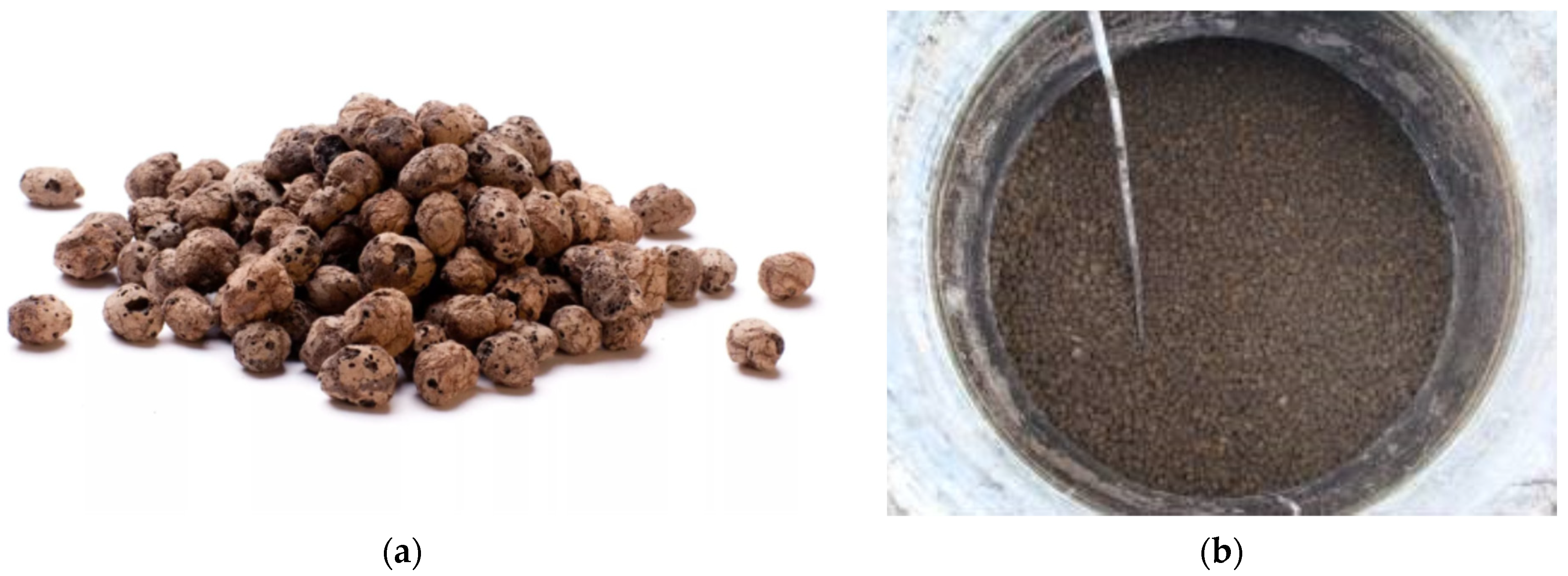
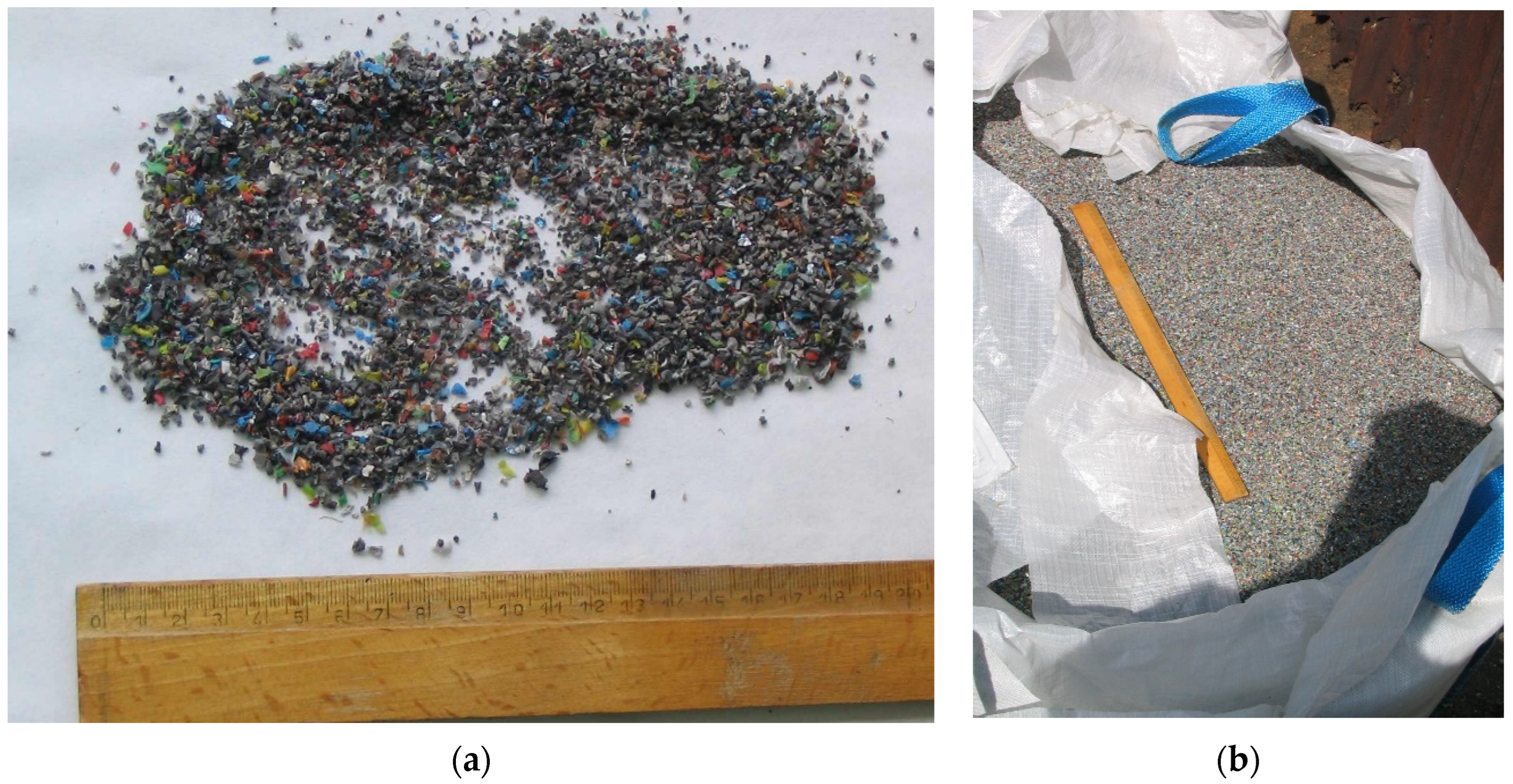


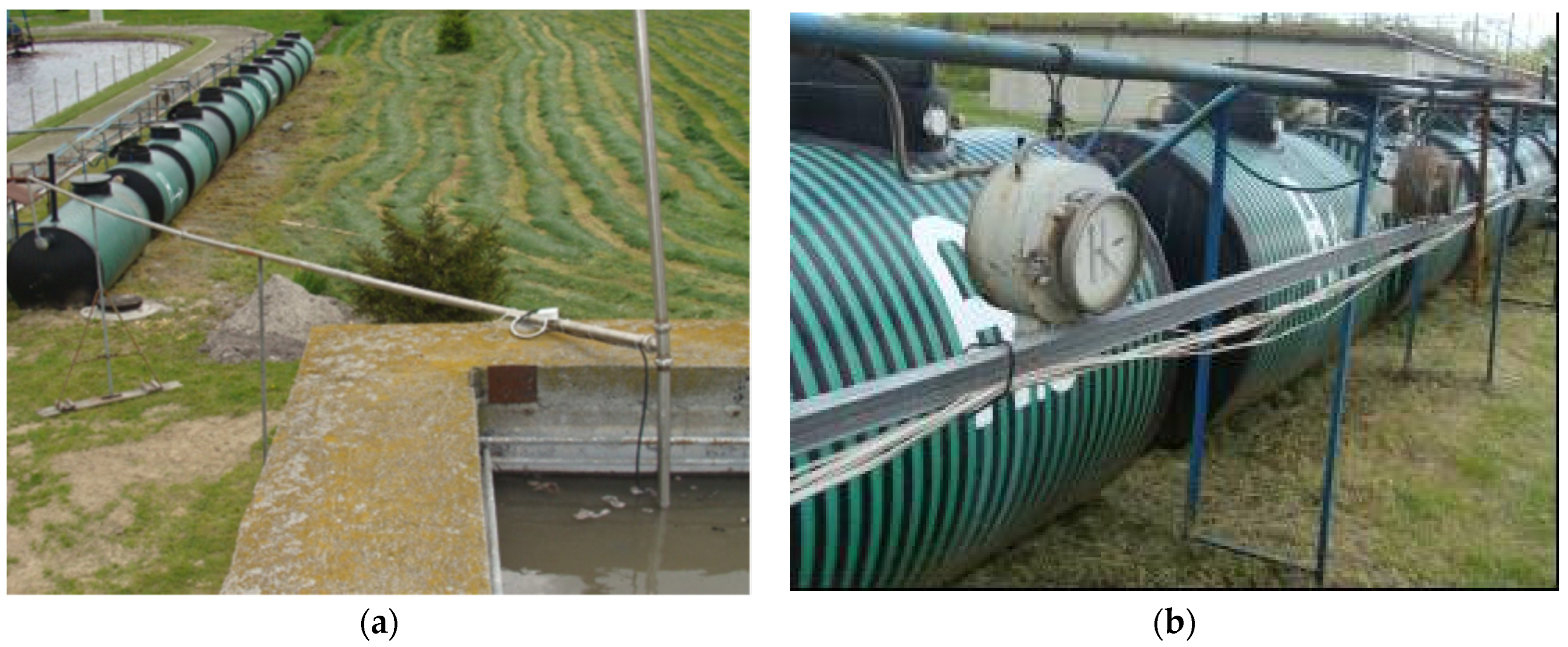
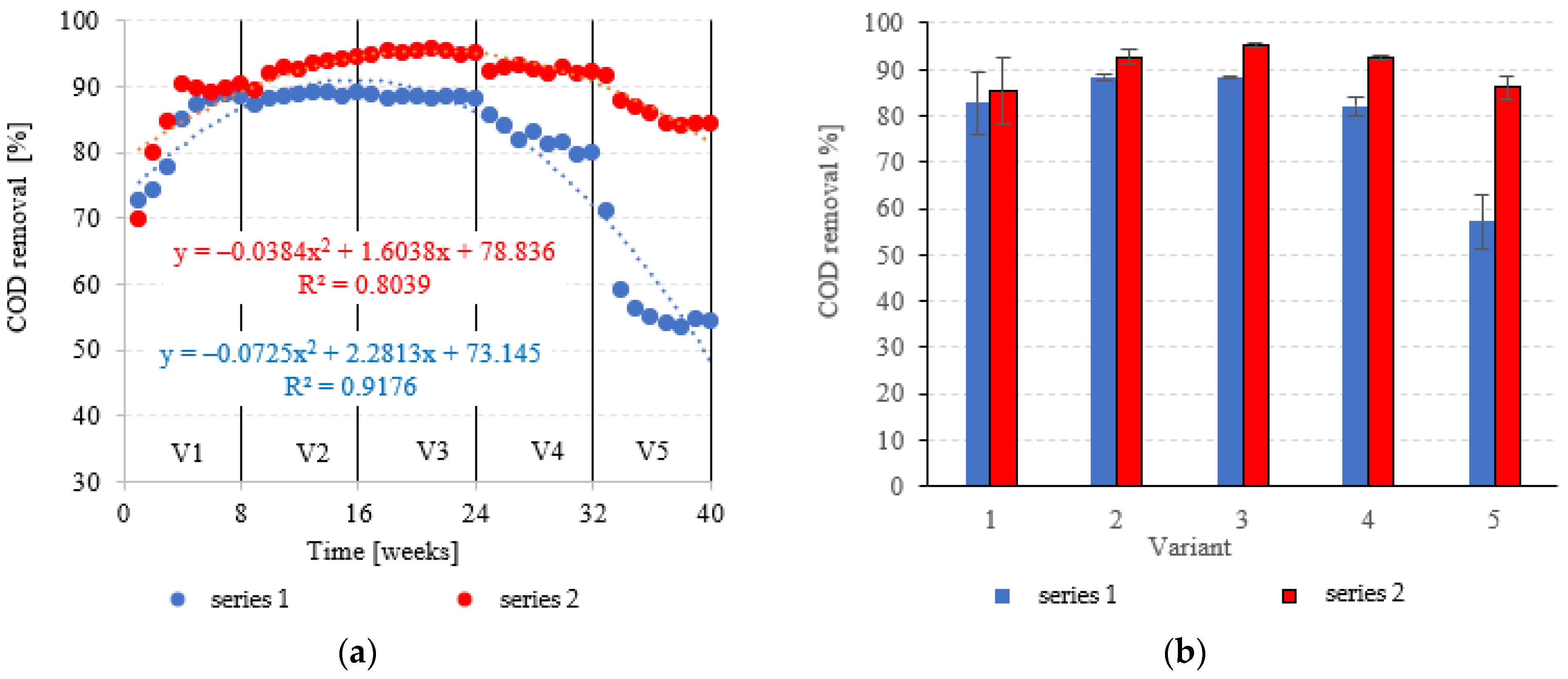
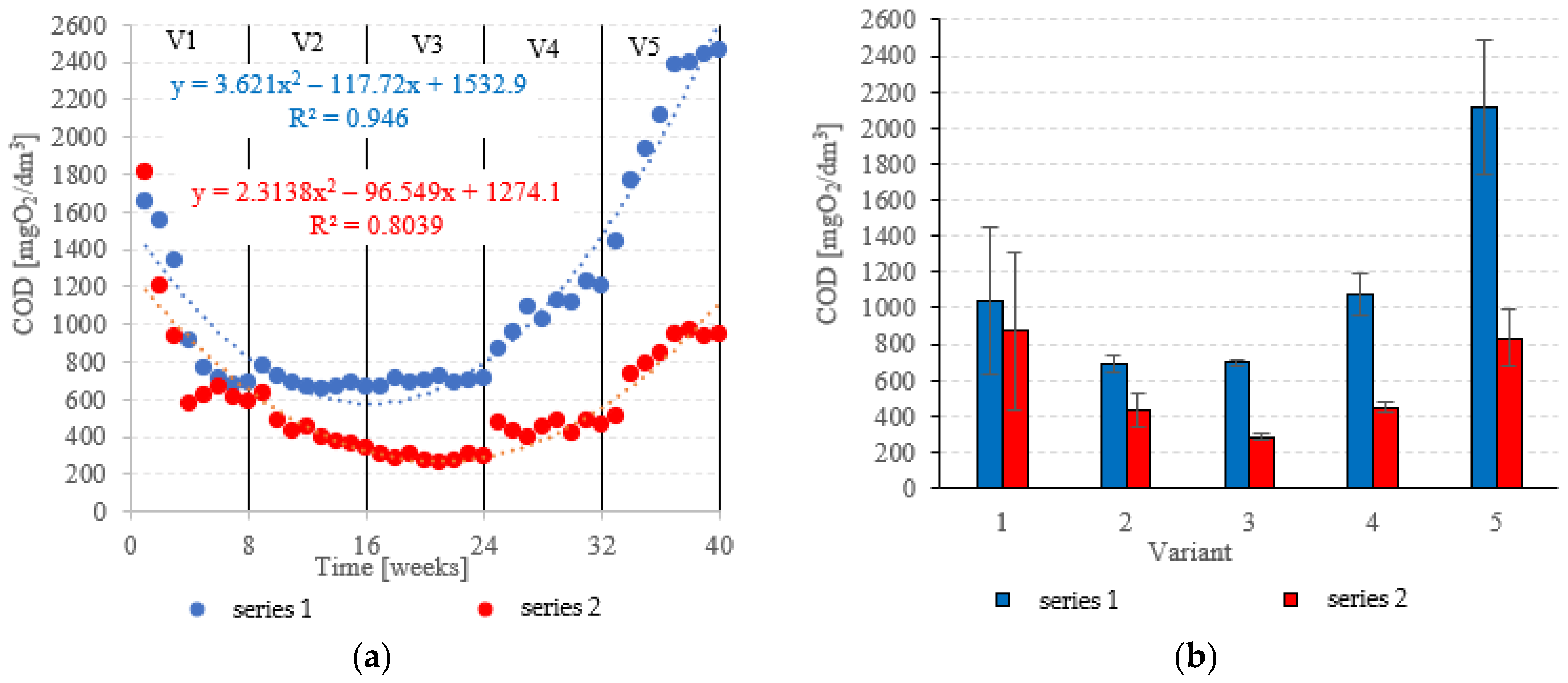

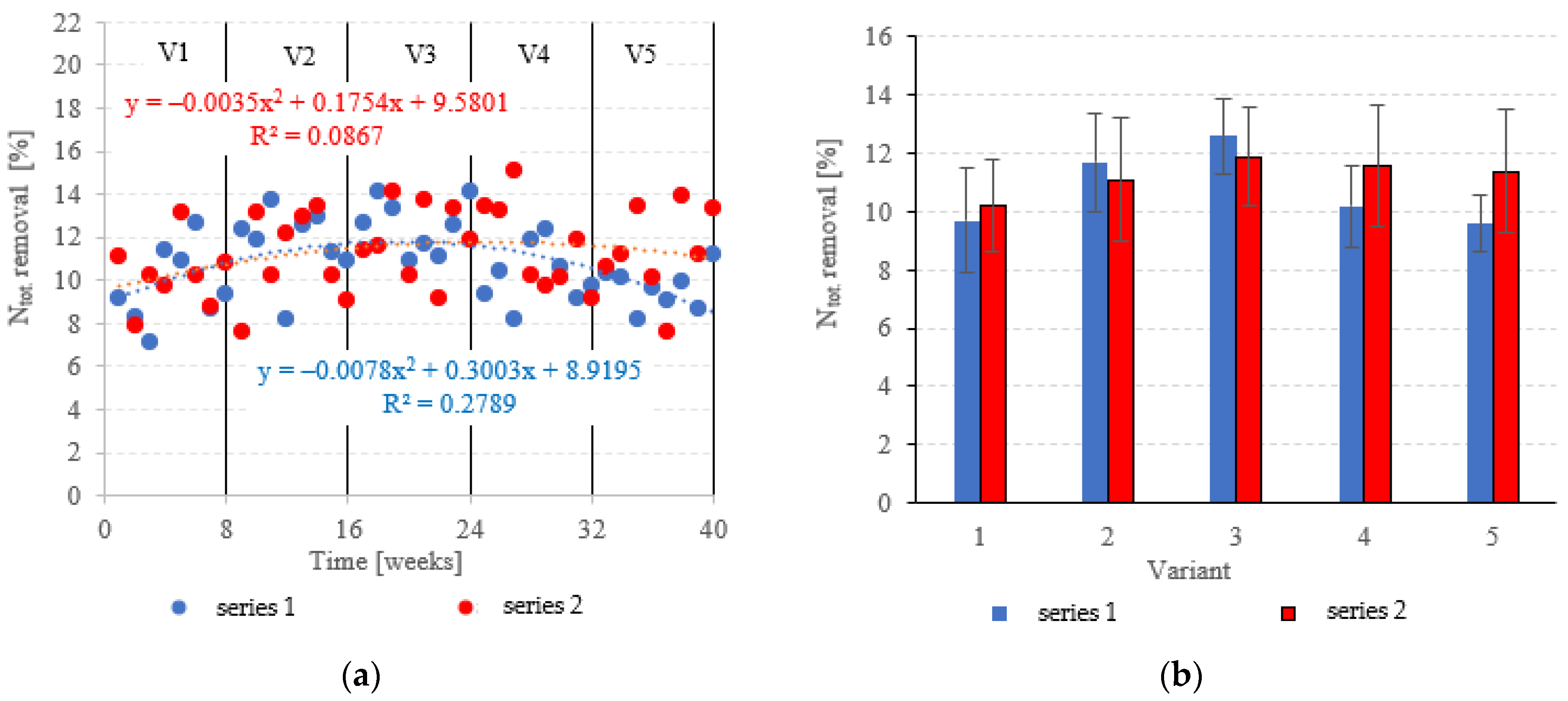
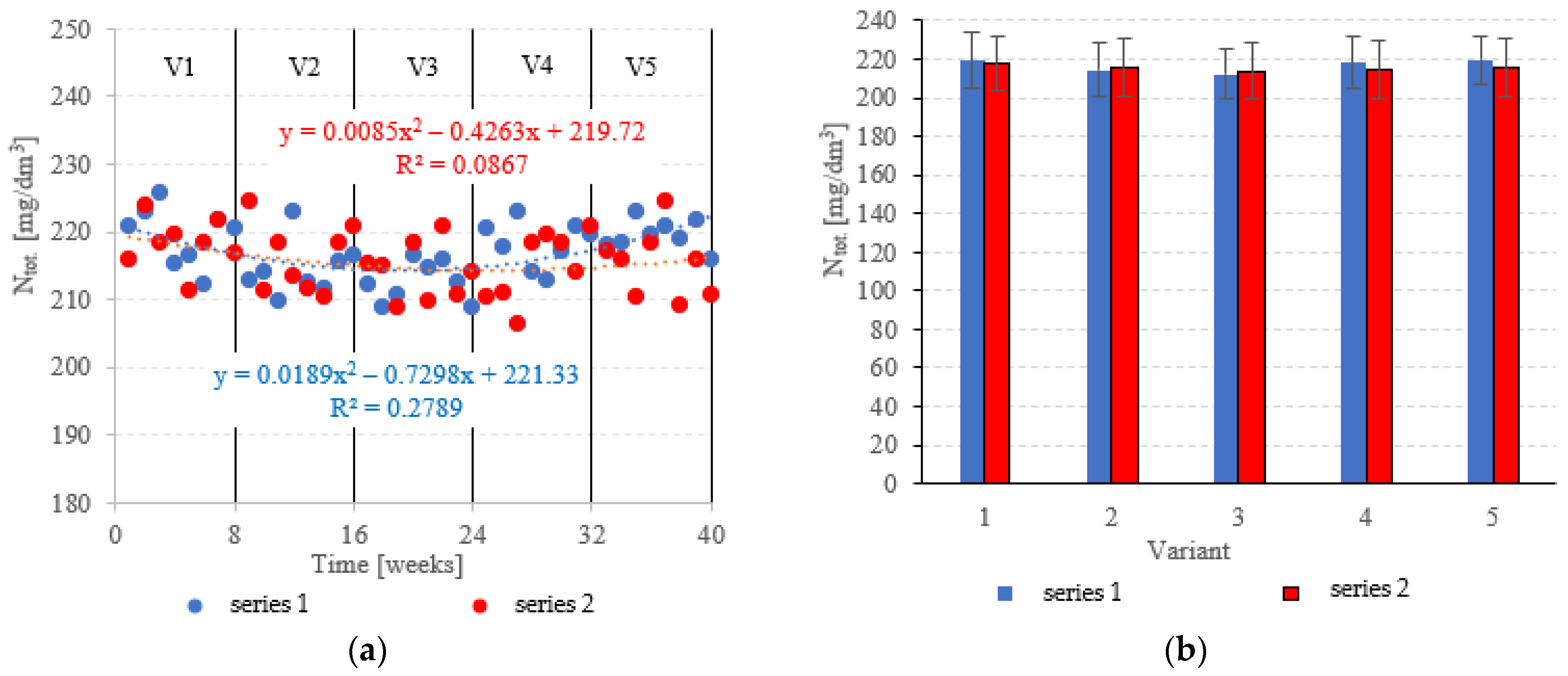
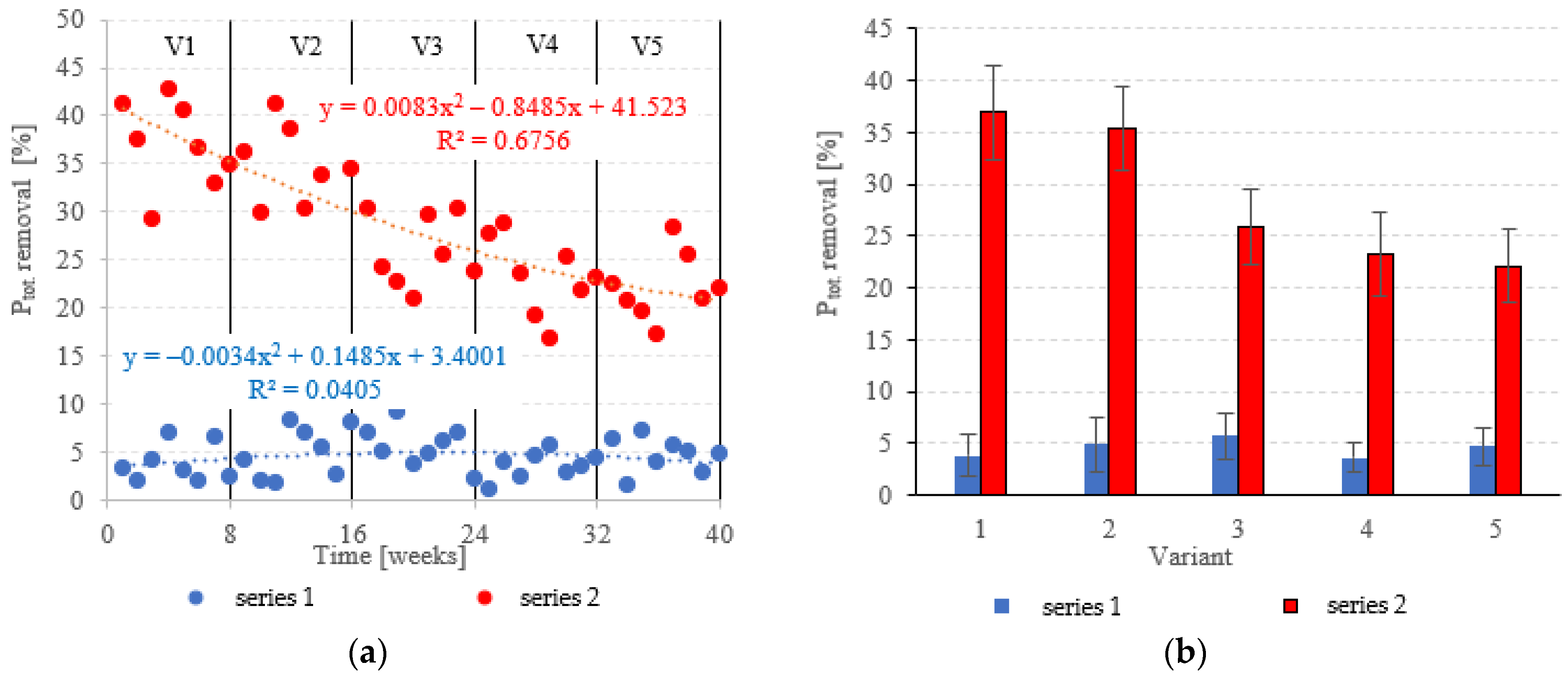

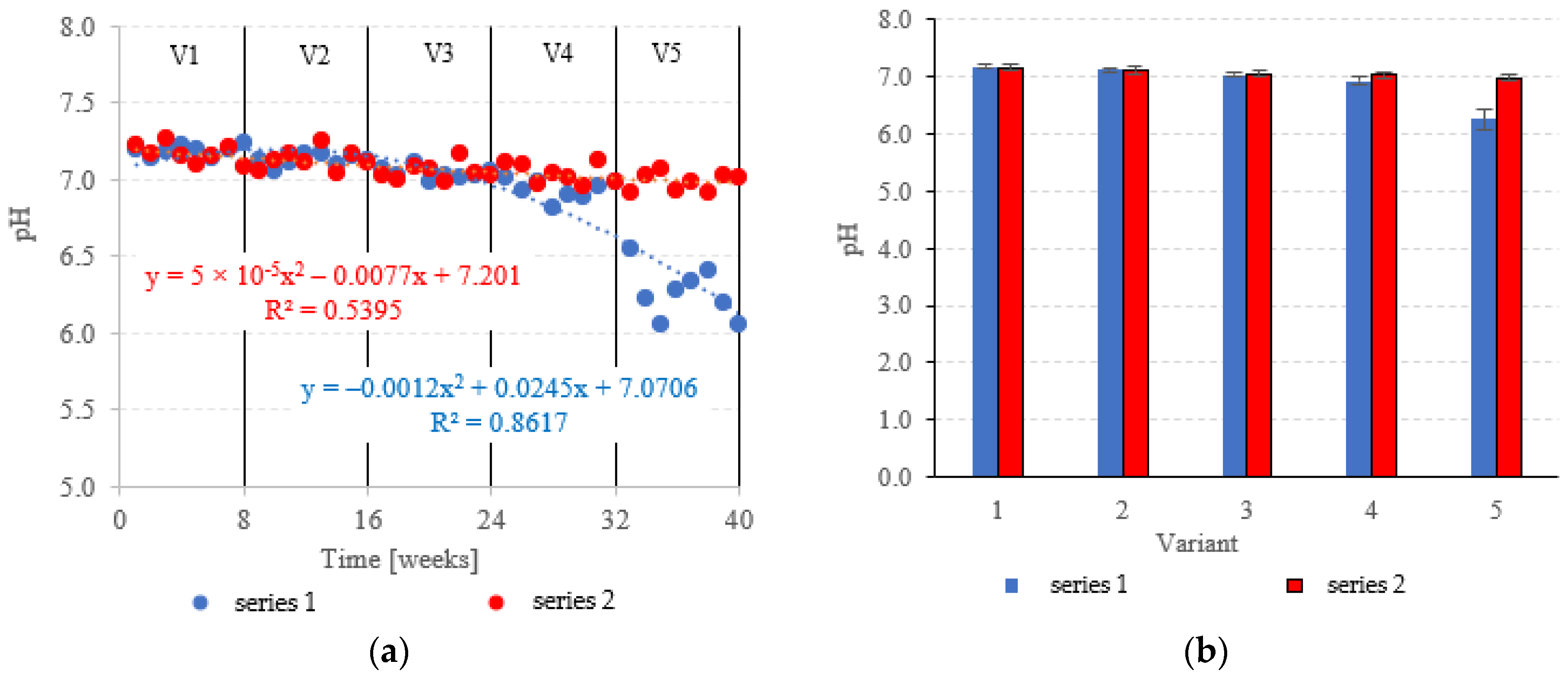
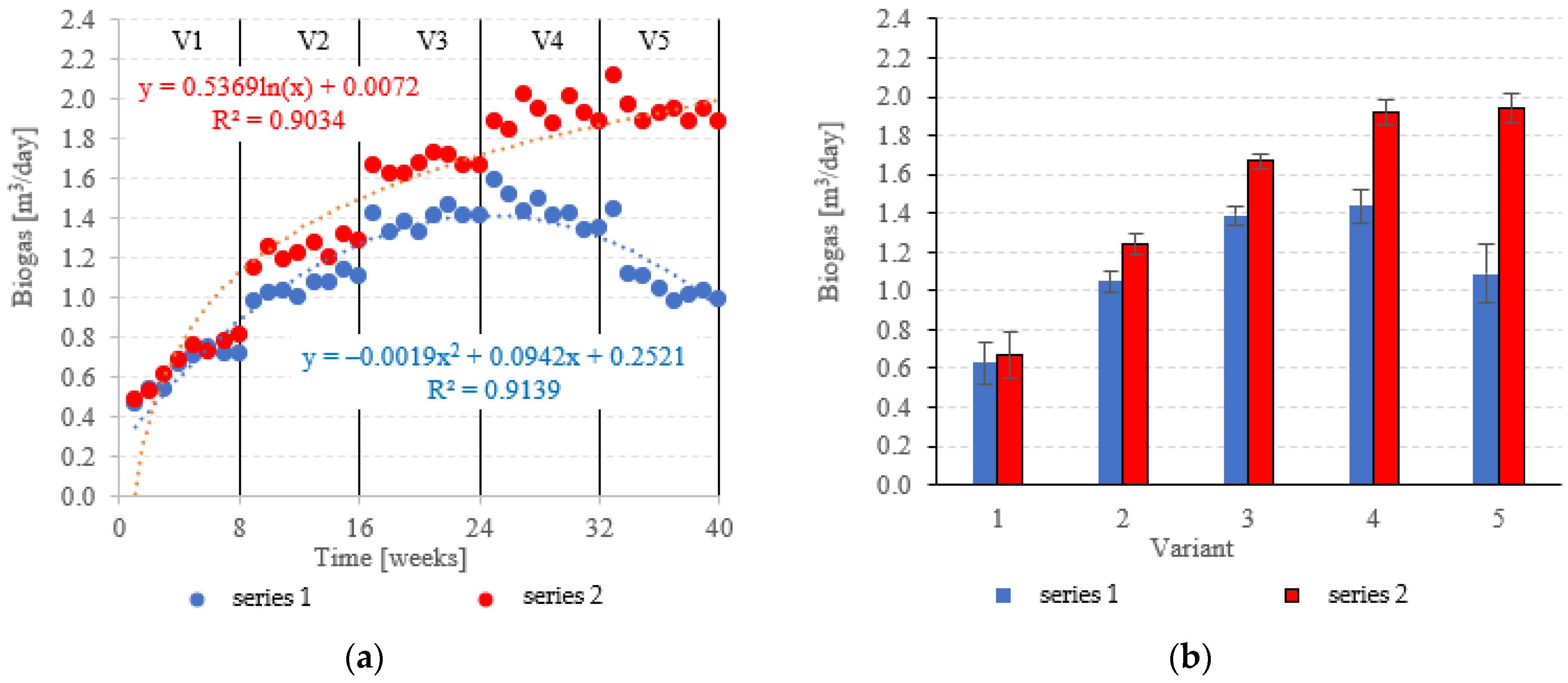
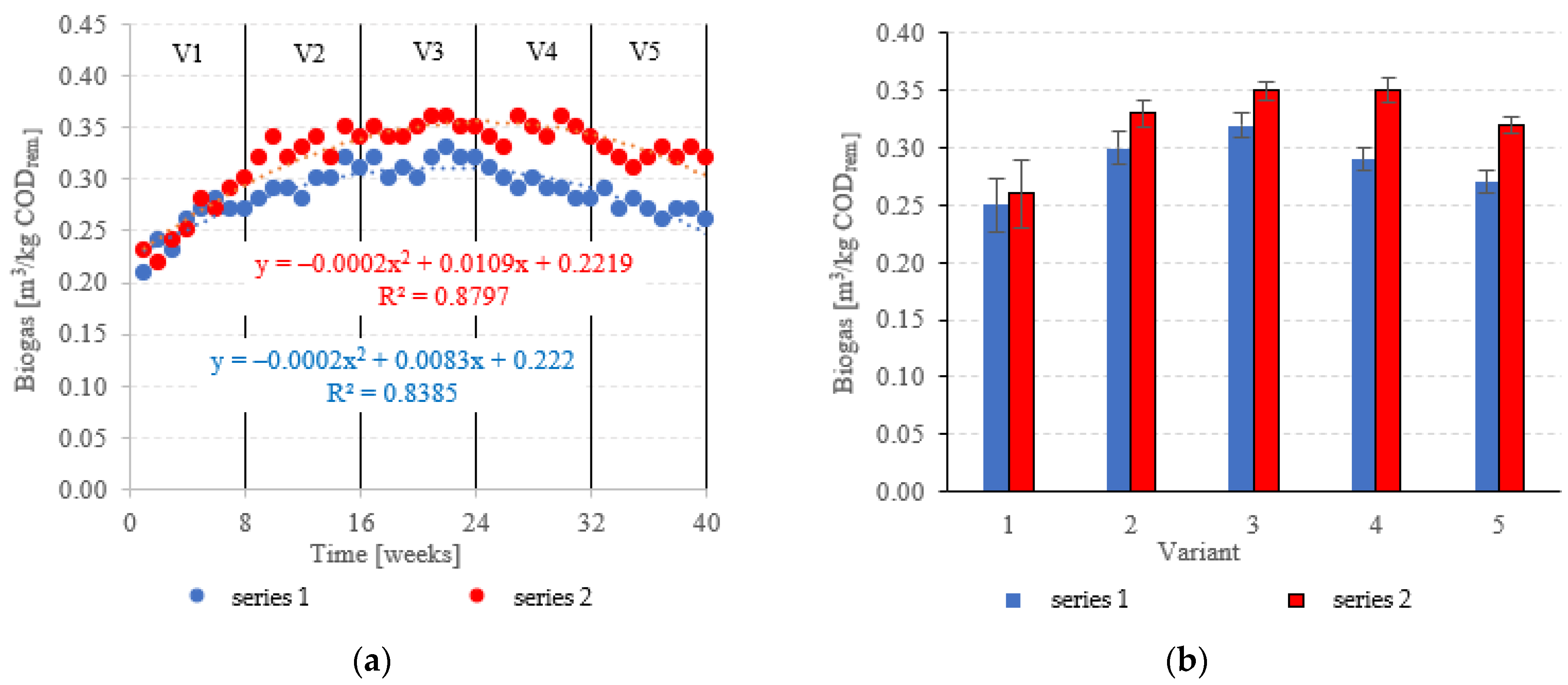


| Parameter | Unit | Mean Value |
|---|---|---|
| COD | [mg O2/dm3] | 6020 ± 595 |
| BOD5 | [mg O2/dm3] | 5317 ± 455 |
| Total P | [mg P/dm3] | 138.2 ± 35.1 |
| Total N | [mg N/dm3] | 242.9 ± 51.4 |
| TSS | [mg/dm3] | 512 ± 94 |
| pH | - | 7.75 ± 0.62 |
| Parameter | Unit | Value |
|---|---|---|
| Water content | (%) | 98.8 ± 0.2 |
| Total solids | (g/dm3) | 29.8 ± 1.7 |
| Mineral solids | (g/dm3) | 8.6 ± 0.4 |
| Volatile solids | (g/dm3) | 21.2 ± 0.6 |
| Filtrate COD | (mgO2/dm3) | 630 ± 27.0 |
| Total P in filtrate | (mgTP/dm3) | 51.0 ± 7.2 |
| Total N in filtrate | (mgTN/dm3) | 89.2 ± 10.1 |
| pH | - | 7.27 ± 0.12 |
| Consortium [%] | Series 1 | ||||
|---|---|---|---|---|---|
| V1 | V2 | V3 | V4 | V5 | |
| Bacteria (EUB338) | 69 ± 9 | 68 ± 7 | 67 ± 11 | 70 ± 7 | 74 ± 8 |
| Archaea (ARC915) | 28 ± 5 | 29 ± 7 | 29 ± 3 | 26 ± 6 | 20 ± 3 |
| Methanosarcinaceae (MSMX860) | 14 ± 2 | 15 ± 3 | 14 ± 2 | 13 ± 2 | 10 ± 3 |
| Methanosaeta (MX825) | 9 ± 2 | 9 ± 3 | 9 ± 3 | 7 ± 2 | 6 ± 2 |
| Consortium [%] | Series 2 | ||||
| V1 | V2 | V3 | V4 | V5 | |
| Bacteria (EUB338) | 68 ± 7 | 67 ± 4 | 66 ± 3 | 66 ± 8 | 68 ± 5 |
| Archaea (ARC915) | 27 ± 5 | 28 ± 2 | 32 ± 6 | 33 ± 5 | 31 ± 3 |
| Methanosarcinaceae (MSMX860) | 14 ± 3 | 13 ± 5 | 17 ± 2 | 17 ± 4 | 16 ± 4 |
| Methanosaeta (MX825) | 6 ± 2 | 8 ± 3 | 11 ± 3 | 11 ± 5 | 10 ± 2 |
| Series | S1 | ||||
|---|---|---|---|---|---|
| Variant | V1 | V2 | V3 | V4 | V5 |
| CH4 [kg/kg CODrem.] | 0.113 ± 0.017 | 0.140 ± 0.010 | 0.151 ± 0.008 | 0.134 ± 0.007 | 0.112 ± 0.007 |
| Series | S2 | ||||
| Variant | V1 | V2 | V3 | V4 | V5 |
| CH4 [kg/kg CODrem.] | 0.116 ± 0.021 | 0.153 ± 0.009 | 0.168 ± 0.006 | 0.170 ± 0.008 | 0.154 ± 0.005 |
Publisher’s Note: MDPI stays neutral with regard to jurisdictional claims in published maps and institutional affiliations. |
© 2022 by the authors. Licensee MDPI, Basel, Switzerland. This article is an open access article distributed under the terms and conditions of the Creative Commons Attribution (CC BY) license (https://creativecommons.org/licenses/by/4.0/).
Share and Cite
Zieliński, M.; Dębowski, M.; Kazimierowicz, J. Performance of an Innovative Low-Cost Recycled Filling (LCRF) in Anaerobic Treatment of Dairy Effluent—A Pilot-Scale Study. Materials 2022, 15, 7815. https://doi.org/10.3390/ma15217815
Zieliński M, Dębowski M, Kazimierowicz J. Performance of an Innovative Low-Cost Recycled Filling (LCRF) in Anaerobic Treatment of Dairy Effluent—A Pilot-Scale Study. Materials. 2022; 15(21):7815. https://doi.org/10.3390/ma15217815
Chicago/Turabian StyleZieliński, Marcin, Marcin Dębowski, and Joanna Kazimierowicz. 2022. "Performance of an Innovative Low-Cost Recycled Filling (LCRF) in Anaerobic Treatment of Dairy Effluent—A Pilot-Scale Study" Materials 15, no. 21: 7815. https://doi.org/10.3390/ma15217815
APA StyleZieliński, M., Dębowski, M., & Kazimierowicz, J. (2022). Performance of an Innovative Low-Cost Recycled Filling (LCRF) in Anaerobic Treatment of Dairy Effluent—A Pilot-Scale Study. Materials, 15(21), 7815. https://doi.org/10.3390/ma15217815









